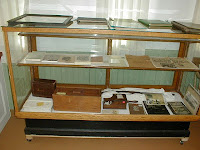The shift continues today with the Internet. Outside the scholarly world of history, individuals are finding their own voices. They are recording their memories for posterity -- perhaps not always consciously. They broadcast their ideas to the world. Archivists are paying attention. We are thinking about how we are going to save these individual voices for the future.
 |
| Our words are important to the study of history |
The Voices
The Internet, and social media in particular, provides a unique platform for the history of the future. And the platform is quickly changing to emphasize those individual voices. Consider Facebook's shift to its "timeline," for example. The platform are giving us the tools to share our life stories as completely as possible. If we can save these voices and stories, historians will have a new unique tool to explore our heritage in a whole new way. The history of dead white men is truly dead. Millions of voices are replacing it.
History is About Us
I am curious to see how history books will not forget us in the future. How will historians sort out the voices to project them in a logical way to students? A few years ago, I came across a theory about teaching history backwards. The concept behind this is that if students see themselves as part of history, they can reach back to better understand the context of events. How did historical events get us to where we are today as a society? How has history helped create the life you live today? History is about us and if we start from that perspective, the context and importance of it all can neatly line up from there.
An Archivist's View
This is my own view and does not necessarily reflect the views of my fellow archivists. (I am interested to hear their comments.) Over the past ten years, I've promoted the idea that caring for your personal papers and caring for the papers of your community can lays a foundation for our archives work in small institutions. This approach fits quite well with the idea of studying history backwards. If we take care of what is most important to us -- our own personal papers and digital records -- and learn to recognize how they fit in with a larger society or collections of papers, than we have more of a vested interest in saving archives. Society has an opportunity to ensure that history books will no longer forget about the general populace. Saving our own memories in recorded form gives historians the tools they need to consider larger groups. Furthermore, a plethora of safely stored recorded information cannot be ignored.
The Internet gives us a unique new tool for the study of history. It is changing our ideas of what a "community" is. It is giving us more communities to consider. Still, our presence is recorded beyond the computer. The papers in our homes still provide a valuable perspective on our lives. Our individual histories exist online and offline. We have the opportunity to care for these recorded perspectives so that history remembers us. Our descendants will look to our lives to better understand their own if we give them the tools.

















